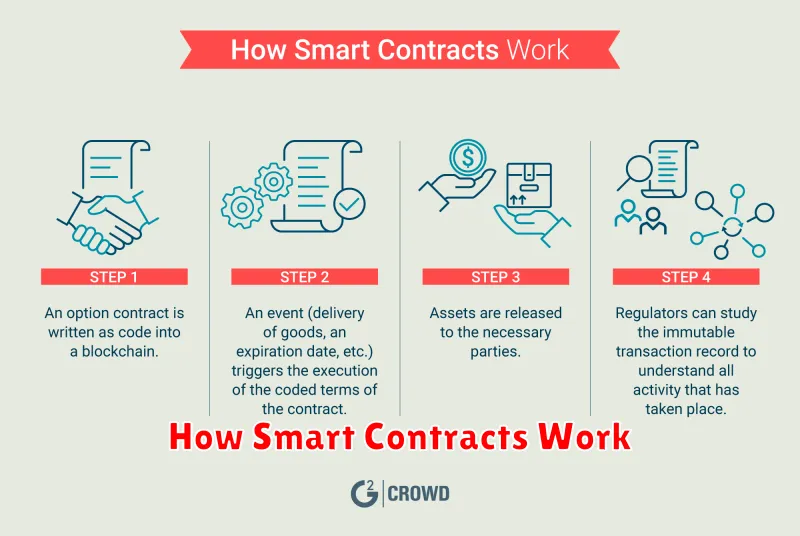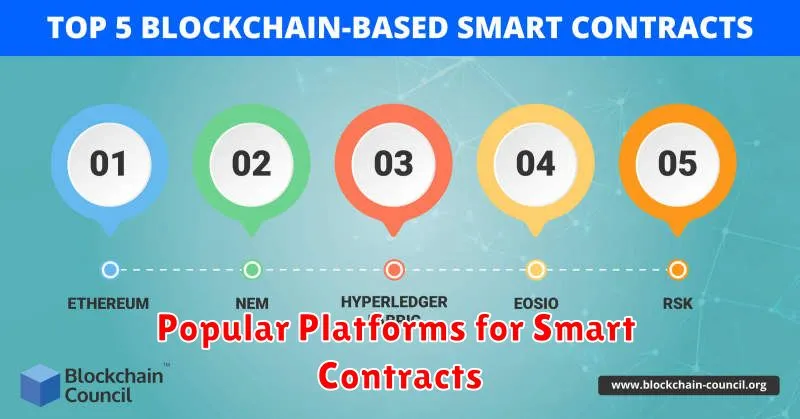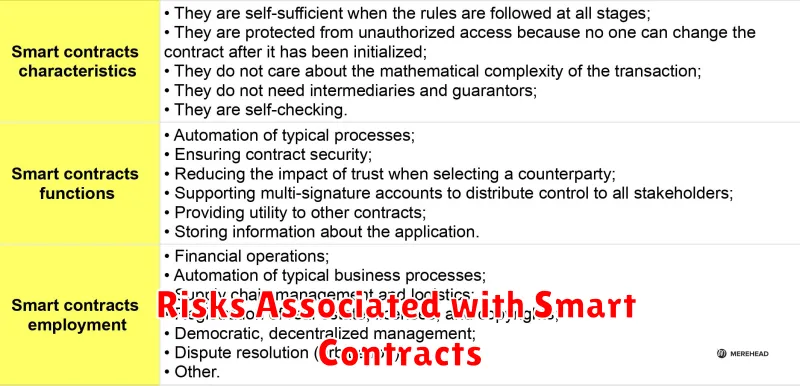Dive into the fascinating world of smart contracts and unlock the potential of cryptocurrency! This comprehensive guide will demystify smart contract technology, exploring how they work, their applications in various industries, and the benefits and risks involved. Learn about the blockchain technology that underpins them, understand the programming languages used, and discover how smart contracts are revolutionizing decentralized finance (DeFi) and beyond. Whether you’re a seasoned crypto investor or a curious beginner, this article will provide you with a clear and insightful understanding of this groundbreaking technology.
What Are Smart Contracts?
Smart contracts are self-executing contracts with the terms of the agreement between buyer and seller being directly written into lines of code. They are stored on a blockchain, a decentralized and transparent digital ledger.
Unlike traditional contracts that require intermediaries like lawyers and notaries, smart contracts automate the execution of an agreement. Once the pre-defined conditions are met, the contract automatically executes, eliminating the need for trust in a third party.
This automation leads to increased efficiency and transparency. All participants can view the contract’s terms and its execution on the blockchain. This creates a higher level of security and reduces the risk of fraud or disputes.
Key features of smart contracts include: automation, transparency, immutability (once executed, the contract cannot be altered), and security facilitated by cryptography.
However, it’s crucial to note that smart contracts are only as good as the code that defines them. Bugs or vulnerabilities in the code can lead to unintended consequences. Therefore, careful development and auditing are essential.
How Smart Contracts Work

Smart contracts are self-executing contracts with the terms of the agreement between buyer and seller being directly written into lines of code. This code is stored on a blockchain, a decentralized and immutable ledger.
The process begins when two or more parties agree to the terms outlined in the smart contract. These terms are then translated into code and deployed to the blockchain. Once deployed, the contract becomes automatically executable based on predefined conditions.
Triggers initiate the execution. These could be anything from a specific date and time to the receipt of funds or the fulfillment of other contractual obligations. When a trigger is met, the blockchain automatically executes the predetermined actions specified in the contract’s code.
This automation removes the need for intermediaries, reducing costs and increasing efficiency. Because the code resides on a decentralized ledger, it’s transparent and tamper-proof, fostering trust and accountability among all parties involved.
Crucially, smart contracts operate based on pre-defined logic; they can’t be altered once deployed (unless explicitly programmed to allow for modifications). This immutability ensures the integrity and reliability of the contract’s execution.
In essence, smart contracts utilize blockchain technology to automate the execution of agreements, eliminating the need for intermediaries and increasing transparency and trust.
Popular Platforms for Smart Contracts

Smart contracts, self-executing contracts with the terms of the agreement between buyer and seller being directly written into lines of code, rely on specific platforms for their execution. The choice of platform significantly impacts factors like cost, speed, security, and scalability.
Ethereum remains the most popular platform for smart contracts. Its vast developer community, mature ecosystem, and established infrastructure make it a leading choice. However, its transaction fees (gas fees) can be volatile and high during periods of network congestion.
Binance Smart Chain (BSC) offers a compelling alternative, prioritizing speed and lower transaction fees compared to Ethereum. Its compatibility with Ethereum’s Virtual Machine (EVM) allows for easier porting of existing smart contracts, but it’s also faced criticism regarding its centralization and security compared to Ethereum.
Solana boasts incredibly high transaction speeds and low fees, making it attractive for projects requiring rapid execution. However, it has experienced network outages in the past, raising concerns about its overall reliability. Its unique architecture also presents a steeper learning curve for developers.
Polygon (MATIC) is a scaling solution for Ethereum, designed to alleviate its scalability issues. By offering faster and cheaper transactions while maintaining compatibility with the Ethereum ecosystem, Polygon has gained significant traction. It functions as a layer-2 solution, improving Ethereum’s overall performance.
Other notable platforms include Cardano, Polkadot, and EOS, each offering unique features and advantages. The best platform for a specific smart contract will depend on its requirements and priorities.
The Benefits of Using Smart Contracts
Smart contracts offer numerous advantages in the cryptocurrency landscape. One key benefit is increased security. Because they are self-executing and operate on a decentralized blockchain, they eliminate the need for intermediaries, reducing the risk of fraud and manipulation.
Another significant advantage is transparency. All transactions and agreements are recorded on the public blockchain, creating an auditable trail that fosters trust among parties involved. This transparency improves accountability and reduces the potential for disputes.
Efficiency is also a major benefit. Smart contracts automate the execution of agreements, eliminating delays and reducing administrative costs associated with traditional contracts. This automation allows for faster transaction processing and streamlined workflows.
Furthermore, smart contracts provide cost-effectiveness. By automating processes and removing intermediaries, they significantly reduce transaction fees and operational expenses. This makes them a particularly attractive solution for businesses and individuals seeking to minimize costs.
Finally, smart contracts offer immutability. Once a smart contract is deployed and executed, it cannot be altered or reversed. This guarantees the enforceability of agreements and protects against unauthorized modifications.
Real-World Applications of Smart Contracts
Smart contracts are transforming various industries beyond cryptocurrency. Their ability to automate agreements and enforce terms automatically is proving invaluable in several real-world applications.
Supply Chain Management is greatly enhanced by smart contracts. Tracking goods, verifying authenticity, and automating payments at each stage of the supply chain increases transparency and efficiency, minimizing fraud and delays. Provenance tracking, ensuring the legitimacy of products, becomes significantly easier.
Healthcare sees applications in secure data management and automated insurance payouts. Smart contracts can facilitate secure sharing of medical records while ensuring patient privacy and streamlining the claims processing, reducing administrative burden.
Digital Identity solutions leverage smart contracts to manage and verify identities. This facilitates secure online interactions and reduces reliance on centralized authorities. Decentralized identity management offers greater user control and data security.
Voting systems can be made more secure and transparent through smart contracts. They ensure accurate vote counting and prevent manipulation, fostering trust in the electoral process. Transparent and immutable voting records increase confidence in election results.
Real Estate transactions can be simplified and made more efficient using smart contracts. Automating property transfers, escrow management, and rent payments ensures greater security and reduces the need for intermediaries.
These examples highlight the versatility and potential of smart contracts. As technology advances, we can expect even more innovative and impactful real-world applications to emerge, revolutionizing various sectors and improving efficiency and transparency.
Risks Associated with Smart Contracts

While smart contracts offer numerous benefits, they also present several significant risks. Understanding these risks is crucial before deploying a smart contract.
One major risk is code vulnerabilities. Errors in the contract’s code can lead to unintended consequences, including loss of funds or assets. Thorough auditing and testing are vital to mitigate this risk.
Bugs and exploits are another concern. Malicious actors can exploit vulnerabilities in the code to steal funds or manipulate the contract’s functionality. Regular security updates and penetration testing can help reduce this risk.
The immutable nature of smart contracts presents a challenge. Once deployed, a contract’s code cannot be easily changed, even if flaws are discovered later. This necessitates meticulous planning and development before deployment.
Oracle manipulation is another significant risk. Smart contracts often rely on external data feeds (oracles) to trigger actions. If an oracle is compromised or provides inaccurate data, the contract’s execution can be affected negatively.
Finally, legal and regulatory uncertainty surrounds smart contracts. The legal enforceability of smart contracts varies depending on jurisdiction, and the lack of clear legal frameworks can pose risks for users.
How to Create Your Own Smart Contract
Creating your own smart contract involves several key steps and a good understanding of programming and blockchain technology. While the specifics vary depending on the blockchain platform you choose (e.g., Ethereum, Solana, etc.), the general process remains similar.
First, you’ll need to choose a programming language. Solidity is the most popular language for Ethereum smart contracts, but other platforms use different languages. Familiarize yourself with the chosen language’s syntax and features. Then, design the logic of your smart contract. Clearly define the contract’s purpose, the data it will manage, and the actions it will perform. This requires careful planning to avoid vulnerabilities and ensure the contract behaves as intended.
Next, you’ll write the code. This involves translating your design into the chosen programming language. Thorough testing is crucial at this stage. Use tools and techniques to identify and fix bugs before deploying the contract to a live blockchain. Remember, bugs in a smart contract can have significant consequences.
After rigorous testing, you deploy the contract to a blockchain network. This involves sending a transaction to the network that includes your contract’s code. Once deployed, the contract becomes part of the blockchain, and its code is executed automatically according to its logic and triggered by specific events.
Finally, monitor your smart contract’s performance. Track its execution, identify any issues, and make necessary updates or upgrades. Remember that smart contracts, once deployed, are immutable; however, you can create a new, updated version. Continuous monitoring is vital for maintaining its functionality and security.
Important Note: Building secure and reliable smart contracts requires expertise in programming, cryptography, and blockchain technology. Consider seeking professional help if you lack the necessary skills.
The Future of Smart Contracts in Crypto
The future of smart contracts in cryptocurrency is bright, promising increased efficiency, transparency, and security across various sectors. We can expect to see significant advancements in several key areas.
Scalability will be a major focus. Current limitations in processing power and transaction speeds on many blockchains hinder widespread smart contract adoption. Solutions like layer-2 scaling and improved consensus mechanisms are crucial for overcoming this hurdle and enabling more complex and resource-intensive smart contracts.
Interoperability is another critical area. The ability for smart contracts on different blockchains to communicate and interact seamlessly will unlock unprecedented possibilities, fostering a more interconnected and collaborative crypto ecosystem. Cross-chain communication protocols are actively being developed to achieve this.
Improved security remains paramount. While smart contracts offer enhanced security compared to traditional contracts, vulnerabilities still exist. Further advancements in formal verification techniques and robust auditing processes will be essential to mitigate risks and prevent exploits.
Decentralized Autonomous Organizations (DAOs) will increasingly rely on smart contracts for governance and operational processes. This will lead to more efficient and transparent management of resources and decision-making within decentralized communities.
Finally, the integration of smart contracts with other emerging technologies, such as Artificial Intelligence (AI) and the Internet of Things (IoT), will unlock even greater potential. Imagine self-executing agreements triggered by real-world events, managed autonomously by AI, and secured by blockchain technology. This convergence promises a future where smart contracts become fundamental building blocks of a truly decentralized and automated world.

